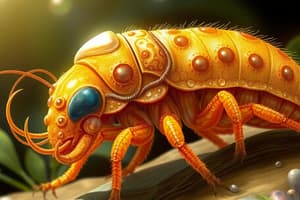Podcast
Questions and Answers
Which of the following scenarios best illustrates the role of a reservoir host in the context of parasitic infections?
Which of the following scenarios best illustrates the role of a reservoir host in the context of parasitic infections?
- A human infected with _Taenia solium_, where the parasite reaches its adult stage and reproduces.
- Wild rodents maintaining a population of _Leishmania_ parasites, intermittently infecting humans without parasitic development in the rodents. (correct)
- A snail hosting larval stages of a trematode before it infects a definitive host.
- A mosquito transmitting malaria parasites to a human, where the parasite undergoes sexual reproduction.
Consider a parasite that requires both a mosquito and a human to complete its life cycle. If the parasite undergoes sexual reproduction in the human host, which of the following classifications is most accurate?
Consider a parasite that requires both a mosquito and a human to complete its life cycle. If the parasite undergoes sexual reproduction in the human host, which of the following classifications is most accurate?
- The human is the definitive host, and the mosquito is the intermediate host. (correct)
- Both the human and the mosquito are intermediate hosts.
- The mosquito is the definitive host, and the human is the intermediate host.
- The mosquito is the vector, and the human is the reservoir host.
In the context of parasitic infections, what is the primary distinction between schizogony and sexual reproduction?
In the context of parasitic infections, what is the primary distinction between schizogony and sexual reproduction?
- Schizogony occurs exclusively in the definitive host, while sexual reproduction occurs in the intermediate host.
- Schizogony is an asexual process resulting in multiple daughter cells, while sexual reproduction involves genetic exchange. (correct)
- Schizogony produces trophozoites, while sexual reproduction produces sporozoites.
- Schizogony involves the fusion of gametes, while sexual reproduction results in merozoite formation.
A protozoan parasite exists in two distinct forms: a metabolically active, feeding form and a dormant, environmentally resistant form. Which terms accurately describe these forms, respectively?
A protozoan parasite exists in two distinct forms: a metabolically active, feeding form and a dormant, environmentally resistant form. Which terms accurately describe these forms, respectively?
Consider a scenario where a new drug effectively inhibits schizogony in Plasmodium. What would be the most direct consequence of this drug's action?
Consider a scenario where a new drug effectively inhibits schizogony in Plasmodium. What would be the most direct consequence of this drug's action?
In the context of parasite classification, which characteristic primarily distinguishes Apicomplexa from Sarcomastigophora?
In the context of parasite classification, which characteristic primarily distinguishes Apicomplexa from Sarcomastigophora?
How do Platyhelminthes differ fundamentally from Nematoda in terms of body structure and organization?
How do Platyhelminthes differ fundamentally from Nematoda in terms of body structure and organization?
Which of the following best describes the relationship between a vector and a parasite it transmits?
Which of the following best describes the relationship between a vector and a parasite it transmits?
Given the classification of protozoa, which of the following parasites would be most likely to possess cilia as a primary means of locomotion?
Given the classification of protozoa, which of the following parasites would be most likely to possess cilia as a primary means of locomotion?
A researcher discovers a new parasite that infects humans. The parasite has a complex life cycle involving an insect vector and an intermediate mammalian host, but reproduces sexually in humans. Based on this information, how should humans be classified in this parasitic relationship?
A researcher discovers a new parasite that infects humans. The parasite has a complex life cycle involving an insect vector and an intermediate mammalian host, but reproduces sexually in humans. Based on this information, how should humans be classified in this parasitic relationship?
Flashcards
Parasite
Parasite
An organism that lives on or in another organism (the host), without benefiting the host. Often a pathogen.
Trophozoite
Trophozoite
The active, growing stage of a parasite, absorbing nutrients from the host.
Cyst
Cyst
Dormant stage of a microorganism, surviving harsh conditions.
Oocyst
Oocyst
Signup and view all the flashcards
Sporozoite
Sporozoite
Signup and view all the flashcards
Schizont
Schizont
Signup and view all the flashcards
Schizogony
Schizogony
Signup and view all the flashcards
Vector
Vector
Signup and view all the flashcards
Primary Host
Primary Host
Signup and view all the flashcards
Intermediate Host
Intermediate Host
Signup and view all the flashcards
Study Notes
Key Terms in Parasitology
- Parasites live on or in another organism (host) without benefiting it and are commonly referred to as pathogens
- Trophozoites are the vegetative or growing stage of some parasites, absorbing nutrients from the host
- Cysts are the dormant stage of a microorganism and can survive under harsh conditions
- Oocysts are thick-walled cells in some protozoan life cycles containing sporozoites
- Sporozoites are the motile, infective stage in some parasitic life cycles, like Plasmodium
- Schizonts are a stage in protozoan parasites where asexual reproduction produces merozoites
- Schizogony is the asexual reproduction process in parasites like Plasmodium, creating multiple offspring
Types of Hosts
- Vectors are organisms that act as intermediate hosts and transfer parasites to another host
- Primary hosts (or definitive hosts) are organisms in which the parasite reaches the adult stage and reproduces sexually
- Intermediate hosts support the immature or non-reproductive forms of a parasite
- Reservoir hosts serve as a source of infection and potential reinfection without parasitic development
Classification of Medically Relevant Parasites
- Protozoa are single-celled parasites
- Metazoans are multicellular parasites
- Medically relevant parasites are classified into protozoa and metazoans
Protozoa Subdivisions
- Sarcomastigophora includes flagellates and amoeboid protozoa
- Apicomplexa includes sporozoans like Plasmodium
- Ciliophora contains ciliated protozoa
- Microspora inlcludes microsporidia
Metazoan Phyla
- Platyhelminthes are flatworms like trematodes (flukes) and cestodes (tapeworms)
- Nematoda are roundworms like Ascaris and hookworms
Studying That Suits You
Use AI to generate personalized quizzes and flashcards to suit your learning preferences.





